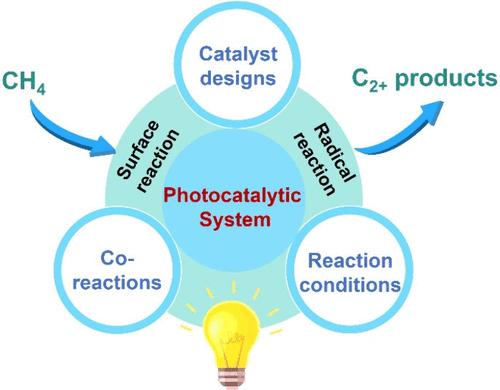光催化甲烷升级为多碳产品
IF 11.3
1区 化学
Q1 CHEMISTRY, PHYSICAL
引用次数: 0
摘要
甲烷既是一种温室气体,也是自然界存在的一种丰富的 C1 燃料资源。将甲烷选择性光催化升级为多碳(C2+)化学品既能缓解温室效应,又能提高甲烷的利用率和价值,其中 C-C 偶联步骤是生产多碳产品的关键。要在常温常压条件下实现这一目标升级,需要高效活化甲烷中的 C-H 键,并平衡各种自由基和 C1 中间体的吸附和解吸,以促进高效的 C-C 偶联。在本综述中,我们将深入探讨甲烷光催化升级为 C2+ 产物的最新进展。首先强调了催化剂设计的重要性,包括活性位点组装、晶体表面和价态重构。然后,我们讨论了如何引入二氧化碳和一氧化碳等核心反应物来增强碳链增长途径。此外,我们还总结了循环系统和光电催化的发展。最后,我们对光催化甲烷升级领域的未来发展进行了展望。本综述旨在为研究光催化甲烷 C-C 偶联反应生成多碳产品提供一个总体框架,从而为环境友好型高效甲烷升级策略提出未来的研究方向。本文章由计算机程序翻译,如有差异,请以英文原文为准。

Photocatalytic CH4 Upgrading to Multicarbon Products
Methane is both a greenhouse gas and an abundant C1 fuel resource that exists in nature. The selective photocatalytic upgrading of methane into multicarbon (C2+) chemicals can both mitigate the greenhouse effect and promote the utilization and value of methane, in which the C–C coupling step is key to the production of multicarbon products. Achieving this targeted upgrading under ambient temperature and pressure conditions requires efficient activation of the C–H bonds in methane as well as the balancing of the adsorption and desorption of various free radicals and C1 intermediates to facilitate efficient C–C coupling. In this Review, we delve into the recent advances in the photocatalytic upgrading of methane to C2+ products. The importance of catalyst design, including the active site assembly, crystal surface, and valence reconstruction, is first emphasized. Then, we discuss how coreactants such as carbon dioxide and carbon monoxide can be introduced to enhance the carbon chain growth pathways. Furthermore, we also summarize the developments of looping systems and photoelectrocatalysis. Finally, we conclude with an outlook for the future advancement in this photocatalytic methane upgrading field. This Review aims to provide a general framework for investigating photocatalytic methane C–C coupling reactions toward multicarbon products, thereby suggesting future research directions toward environmentally friendly and efficient methane upgrading strategies.
求助全文
通过发布文献求助,成功后即可免费获取论文全文。
去求助
来源期刊

ACS Catalysis
CHEMISTRY, PHYSICAL-
CiteScore
20.80
自引率
6.20%
发文量
1253
审稿时长
1.5 months
期刊介绍:
ACS Catalysis is an esteemed journal that publishes original research in the fields of heterogeneous catalysis, molecular catalysis, and biocatalysis. It offers broad coverage across diverse areas such as life sciences, organometallics and synthesis, photochemistry and electrochemistry, drug discovery and synthesis, materials science, environmental protection, polymer discovery and synthesis, and energy and fuels.
The scope of the journal is to showcase innovative work in various aspects of catalysis. This includes new reactions and novel synthetic approaches utilizing known catalysts, the discovery or modification of new catalysts, elucidation of catalytic mechanisms through cutting-edge investigations, practical enhancements of existing processes, as well as conceptual advances in the field. Contributions to ACS Catalysis can encompass both experimental and theoretical research focused on catalytic molecules, macromolecules, and materials that exhibit catalytic turnover.
 求助内容:
求助内容: 应助结果提醒方式:
应助结果提醒方式:


